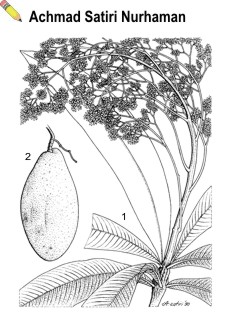Record Number
6693
PROSEA Handbook Number
2: Edible fruits and nuts
Taxon
Mangifera kemanga Blume
Protologue
; Mangifera Kemanga: Mus. Bot. Lugd. Bat. 1: 202 (1850).
Family
ANACARDIACEAE
Chromosome Numbers
2n = 40
Synonyms
— Mangifera kemanga: Mangifera polycarpa Griffith (1854), Mangifera caesia Jack var. kemanga (Blume) Kostermans (1965).
Vernacular Names
— Mangifera kemanga: Kemang (En, Fr). Indonesia: kemang (Sundanese, West Java; Malay, Sumatra), palong (Kutai, East Kalimantan). Malaysia: kemang (Malay, Borneo).
Origin and Geographic Distribution
The species have the same natural distribution: Sumatra, Borneo and Peninsular Malaysia. They are rather rare in forests and found more frequently in periodically inundated areas and marshes. In cultivation binjai has spread to Bali, Peninsular Thailand and, rarely, to western Java. Binjai has apparently been moved by the Sulus from northern Borneo to the Sulu Archipelago and to Mindanao, notably around Zamboanga and near Butuan in the Agusan valley where it abounds. Kemang is commonly cultivated in western Java, especially near Bogor, but less frequently in Borneo where binjai dominates.
Uses
The juicy, sweetish-sour binjai fruit can be eaten fresh when ripe. The 'wani' form, which is mainly found in Bali but also in East Kalimantan, is much liked this way and fetches a high price in local markets, as the fruit is palatable, juicy and sweet, almost fibreless, the foetid rank smell being completely absent. It is excellent for making creamy juices. Binjai is often used to prepare a spice based on chillies ('sambal') which is eaten with river fish. In some areas the flesh of ripe fruit is pickled and preserved with salt in jars, to be able to make this sambal when there is no fresh fruit.
Kemang fruit is eaten fresh when ripe, or used for home-made juice. It is used unripe to make 'rujak', a dish of sliced green fruit covered with a spicy sauce. Occasionally a dish is made from fresh, grated seeds, with fermented soya beans and spices. The Sundanese in western Java commonly eat the young leaves in 'lalab', a dish of fresh leafy vegetables.
Kemang fruit is eaten fresh when ripe, or used for home-made juice. It is used unripe to make 'rujak', a dish of sliced green fruit covered with a spicy sauce. Occasionally a dish is made from fresh, grated seeds, with fermented soya beans and spices. The Sundanese in western Java commonly eat the young leaves in 'lalab', a dish of fresh leafy vegetables.
Properties
About 65% of the binjai fruit is edible. Per 100 g edible portion the constituents are: water 86.5 g, protein 1 g, fat 0.2 g, carbohydrates including fibre 11.9 g, ash 0.4 g, thiamine 0.08 mg, ß-carotene equivalent 0.005 mg and vitamin C 58 mg. The energy value is 200 kJ/100 g. The white juice of the immature binjai fruit is extremely irritant, both on the skin and when ingested; it has been used to injure enemies! The juice of kemang is not injurious to the skin.
Botany
Mangifera kemanga is closely related to Mangifera caesia, with which it is united by some botanists (e.g. in Flora Malesiana). It should, however, be considered as a species distinct from Mangifera caesia. It can be recognized by its subsessile leaves with narrowly decurrent margins; its panicles which are longer (up to 75 cm long), more open and contain fewer flowers; its fruits which are dull yellow-brown at maturity, gibbous at the base and scurfy. Natural hybrids between Mangifera kemanga and Mangifera caesia, showing intermediate characteristics, are found in orchards in East Kalimantan.
Image
 | Mangifera kemanga Blume - 1, flowering branch; 2, branchlet with fruit |
Ecology
Mangifera caesia and Mangifera kemanga are restricted to the wet tropical lowlands, generally below 400 m (rarely up to 800 m). They require a rainfall which is evenly distributed through the year. Both species stand inundation well and are commonly cultivated on periodically inundated riverbanks in East Kalimantan.
Agronomy
Both species are propagated from seed, an indication that the agronomy of the crops has received little attention. Presumably grafting on seedling stock would be possible, in particular through inarching potted, decapitated rootstocks into twigs of mother trees. Grafting on Mangifera indica L. has been attempted without success, probably because this species is not closely related. Mature trees require much space, 12—16 m each way. No particulars about husbandry, pests and diseases or yield levels have been published. Ripe fruit must be handled with care as it is soft and juicy.
Prospects
Vegetative propagation of superior types with the added advantages of early bearing and a more manageable tree size may enable binjai and kemang to gain importance. In particular the best forms of 'wani', i.e. those from Bali and East Kalimantan, would merit wider cultivation, as the fruit has an excellent and unique flavour.
Literature
Ding Hou, 1978. Anacardiaceae. In: van Steenis, C.G.G.J. (Editor): Flora Malesiana. Series 1. Vol. 8. pp. 438—439.
Kostermans, A.J.G.H., 1965. New and critical Malaysian plants. VII. Mangifera caesia Jack. Reinwardtia 7(1): 19—20.
Mukherjee, S.K., 1949. A monograph of the genus Mangifera L. Lloydia 12: 73-136.
Ochse, J.J. & Bakhuizen van den Brink, R.C., 1931. Vruchten en vruchtenteelt in Nederlandsch-Indië [Fruits and fruit cultivation in the Dutch East Indies]. Kolff, Batavia. pp. 3—4.
Kostermans, A.J.G.H., 1965. New and critical Malaysian plants. VII. Mangifera caesia Jack. Reinwardtia 7(1): 19—20.
Mukherjee, S.K., 1949. A monograph of the genus Mangifera L. Lloydia 12: 73-136.
Ochse, J.J. & Bakhuizen van den Brink, R.C., 1931. Vruchten en vruchtenteelt in Nederlandsch-Indië [Fruits and fruit cultivation in the Dutch East Indies]. Kolff, Batavia. pp. 3—4.
Author(s)
J.M. Bompard
Correct Citation of this Article
Bompard, J.M., 1991. Mangifera kemanga Blume. In: Verheij, E.W.M. and Coronel, R.E. (Editors): Plant Resources of South-East Asia No 2: Edible fruits and nuts. PROSEA Foundation, Bogor, Indonesia. Database record: prota4u.org/prosea

All texts are licensed under a Creative Commons Attribution-Noncommercial-Share Alike 3.0 Netherlands License
This license does not include the illustrations (Maps,drawings,pictures); these remain all under copyright.